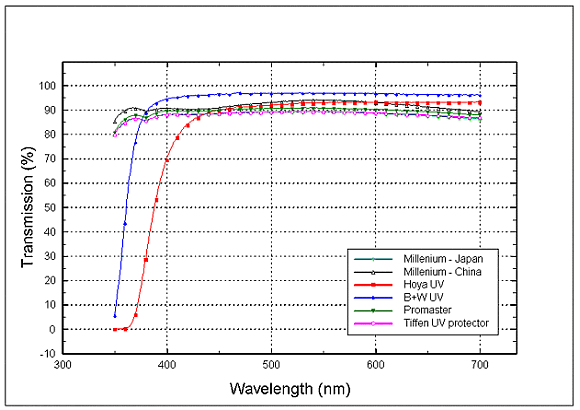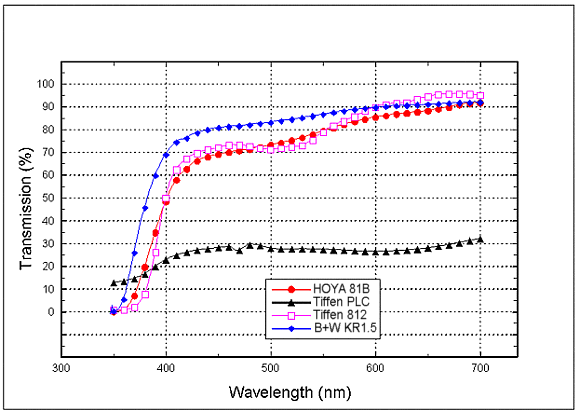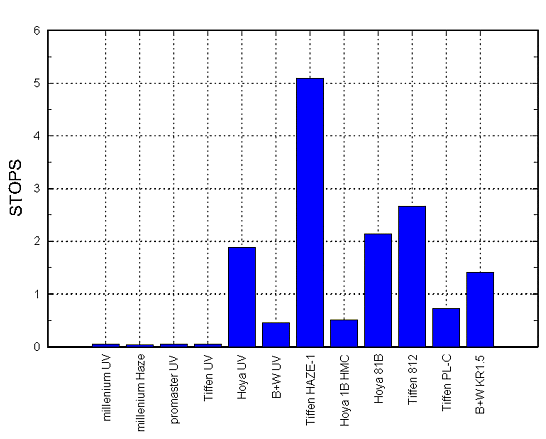
|
UV and Warming Filters[The following is based on data taken a number of years ago. While it's possible some filter formulation may have changed since this data was taken, it's probably unlikely]
What is UV and why would you want to block it?UV filters are supposed to block UV light. So, for the newcomers to photography let's first look at what UV light is and why you would want to block it. The "traditional" visible spectrum runs from red to violet. Red light has the longest wavelength and violet the shortest. Light which has a longer wavelength than red is called infrared, and light which has a shorter wavelength than violet is called ultra violet or UV. The wavelength of light is measure in units of nanometers (abbreviated as nm), and 1nm is a billionth of a meter (that's a US billion or 1000 million, not a UK billion which is a million million!). Light shorter in wavelength than about 400nm is called ultra violet, light longer in wavelength than 700nm is called infrared.
 So now we know what UV light is, why would be want to block it? Well the answer lies in the way that color film works. There are basically three color sensitive layers, one sensitive to red light, one to green light and one to blue light. The blue layer not only responds to blue light, but also to UV light, so if there is a lot of UV around the blue sensitive layer gets extra exposure and the final image takes on a blue color. Since film isn't normally sensitive to infrared, you don't need an infrared blocking filter. Interestingly though, digital sensors are infrared sensitive and most digital cameras have an infrared blocking filter built in. Digital sensors also have intrinsic UV sensitivity and can also suffer from UV effects, though in the case of digital it's relatively easy to make post exposure color corrections, plus the Automatic White Balance function (if in use) may make corrections before exposure Now there isn't usually a huge amount of UV around at sea level. There is some (that's what gives you a suntan or a sunburn) but most of it is scattered by the atmosphere. However as you gain altitude, for example by going up a mountain, the amount of UV increases. Under these conditions a UV filter can prevent a blue cast in photographs. Since UV filters look clear and neutral to the naked eye, some people also use them as a protective filter which they leave on their lens at all times. Some people think this is a good idea, other question the wisdom placing a $20 filter in front of a $1000 lens and potentially affecting image quality. Both schools of thought have some valid points. It's your choice. The negative effects of a good filter are very small indeed and should be undetectable. However a bad filter can ruin an image and lead to a drop in contrast due to flare. Multicoated filters can pretty much eliminate flare problems though. So if you buy a UV filter, you'd expect it to block UV right? Well, sometimes you'd be
wrong as the results of this test show. I've looked at the range between 350nm and 400nm
for UV blocking since the glass used in almost all lenses will itself block any light with
a wavelength shorter than 350nm, so you don't need help from a filter there. The TestsThe filters were measured using a calibrated UV/visible spectrophotometer which I had access to at the time of the tests. The plot below shows the transmission characteristics of a number of "UV filters". There are 3 "generic" type filters, a Millennium (marked "made in Japan"), a second Millennium (this one marked "made in China") and a Promaster, plus 3 "name brand" filters, a Tiffen UV protector, A Hoya UV filter and a B+W UV filter. As you can see from the plot, the 3 "generics" along with the Tiffen UV protector really did not cut any appreciable UV down to 350nm. The Hoya and B+W filters showed definite UV absorption, the Hoya being more effective at UV blocking.  In addition to the UV filters I also looked at a three filters often used in place of a UV filter (i.e. filters which some photographers keep on the lens at all times as protection). These are the Hoya 81B, the Tiffen 812 and the B+W KR1.5. All three are warming filters in that they shift the color balance towards the red (warm) end of the tonal range. With film, warming filters are useful, but with digital, again corrections which mimic the effect of a warming filter can be easily be made post exposure. I also included a Tiffen circular polarizer, just because I had one around! As you can see all three of the warming filters were effective UV absorbers, as well as slight absorbers in the blue and green regions of the spectrum (which is what makes them warming filters). The polarizer absorbed slightly more in the UV than the visible, though I wouldn't call it an effective UV absorber.  Another interesting way to look at UV blocking is to calculate the effective number of stops that the filter attenuates for the wavelengths between 350nm and 400nm compared to transmission in the visible. The data are plotted below on that basis. For example the Tiffen Haze-1 filter looks like a 5 stop filter to UV wavelengths in that range, while the low cost generics and the Tiffen UV protector show less than 0.1 stop attenuation of UV.  This last plot makes the order of UV absorbing effectiveness quite clear
What to BuyWell, it depends on what you want! If you just want to a "protective" filter, any of them will be OK, but personally I'd go with a Hoya UV Super-multi Coated if you want to leave it on the camera all the time. The Super Multi Coated (SMC) series have the very best anti-reflection coatings and so will be less likley to lower image contrast. They are a little more expensive than non-coated, mono-coated or multi-coated filters, but for a filter to be left on a lens all the time, it's worth it.If you want a really effective UV filter for use with film, then the Tiffen UV Haze is clearly the best choice. Most Tiffen filters do not come in multicoated versions, so there's a little more risk of flare. However using a lens hood should prevent such problems. If you need a good UV blocking filter for occasional use, the Tiffen Haze series filters are the ones to get. If you're shooting film an want a warming filter, I really like the Tiffen 812. Again, being a Tiffen filter, it's not multi-coated. I use one, but I also use lens hoods, and I don't generally have flare problems. If you want a multi-coated filter, the Hoya 81B multi-coated is a good choice. It's effect is quite similar to that of the Tiffen 812. To keep filters and lenses clean, a Microfiber Lens Cleaning Cloth is well worth buying. I use a couple of microfiber cloths and they are remarkable in their ability to wipe away grease spots and fingerprints! Just make sure the cloth is clean before you use it. They can be washed if they get dirty.
© Copyright Bob Atkins All Rights Reserved |
|